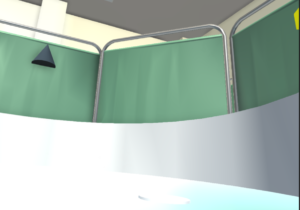The HVS 6D VR Morris Water Maze provides a direct human equivalent to the rodent task, based on HVS Image’s 40 years’ work with water maze scientists since HVS developed the original tracking and analysis system for Richard Morris. Scientists can choose to place subjects into a realistic rodent’s eye view of the Morris water maze task, or an idealized version where the environment is entirely uniform other than objects placed by the experimenter, such as visual cues.
Human participants wear a virtual reality headset, allowing them to look around the arena, with head turning providing vestibular input. They navigate either by simulating walking on an omnidirectional treadmill (with safety rail) or portable treadplate, which importantly provide proprioceptive input, by hand (using VR controllers, gamepad or keyboard), by head movements or by voice. All methods allow the participant to move naturally through the environment. An alternative option is to have participants navigate the VR water maze by physically moving around in a suitably sized, empty space.
The subject’s position and movement through the virtual environment is tracked by the HVS Image software, which gives path plots and scientific measures and analyses equivalent to those used in the animal paradigm, with sophisticated analyses allowing you to distinguish accurately between spatial learning and other strategies used to find the hidden platform location. These definitive HVS Image measures and analyses are recognized as the best set of scientific Morris water maze analyses.
The 2D videos don’t do justice to the VR experience but are provided as illustration of some of the options:
Clip from a regular trial with an unscreened laboratory background:
Clip from a visible platform trial, using an idealized environment – no reflections, no shadows, no external walls etc:
HVS Image virtual reality Morris water maze for humans makes the following analyses available. You can choose as many or as few as you like to include in your results files.
- Latency
- Path length
- Average speed

This is the same laboratory with screens placed to simulate the typical method of removing extraneous cues. A dark conical cue is visible in this view. - Active speed (average speed corrected for time spent inactive)
- Percentage of time not moving, or moving below a certain speed
- Percentage of time in each quadrant
- Percentage of path in each quadrant
- Percentage of time in each zone
- Heading (angle relative to ideal path)
- Percentage of time in thigmotaxis
- Percentage of path in thigmotaxis
- Number of passes through counters (defined space around target positions)
- Percentage of time in counters
- Latencies to counters
- Close encounter time and path
- Corridor Test (derived from Wishaw Corridor Test but handles any start point to any platform position and normalizes the result to allow for different corridor areas)
- Cone Test
- Pool Circling
- Kelly Test
- Gallagher Measures (e.g. Gallagher Proximity Measure, Gallagher Cumulative Measure)
- Quad Entries
- Path Efficiency Ratio (actual path length / direct path length)
- Time-bins
- Gallagher by Segment
- Speed vs Time
- Pool zones can be equi-spaced or equi-area.
We provide you with a complete, standalone system including all the hardware and software you need: a specially selected high spec laptop or PC, the VR headset and accessories, our omnidirectional treadmill or treadplate (optional), the HVS 6D VR software with default and sample configuration files for your chosen environment(s) and experiment types, tracking of subject behavior and our analysis software that gives you path plots and analyses.
Experiment configuration is both simple and powerful, with our user-friendly scripting language (no programming skills needed) allowing you to set up both individual trials and series of trials in a text editor, specifying everything from the overall environment to trial details such as the length of time the participant stays on the platform after successfully finding it. Analysis is in .csv format, for easy viewing in Excel and other packages, with raw data in JSON and text format. Details have been worked out with scientists using the system so you can be sure of both scientific rigor and practicality in all aspects.
The system we provide is entirely self contained, handling experimental setup, running trials and providing results, and your work is not dependent on any third party services. For convenience you can also configure experiments and analyze results on additional computers if you wish to.
As well as the laboratory and idealized water maze environments, other options include super-realistic luxury apartment, suburb, mountains and forest, where specific tasks can be set by the experimenter, including real world tasks involving spatial learning and memory. We can also provide other environments if needed for your experiments, and any specific experimental tasks and analyses you need. We encourage you to contact us to discuss your plans.
External view of the VR Morris water maze. The experiment is normally run from the rodent’s point of view within the pool, either with screens around the pool to replicate the animal experience, or with an idealized, plain environment where nothing is visible to the participant other than the cues you place.
